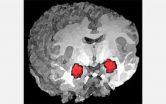(Press-News.org) ITHACA, N.Y. - Tomorrow's nonvolatile memory devices – computer memory that can retain stored information even when not powered – will profoundly change electronics, and Cornell University researchers have discovered a new way of measuring and optimizing their performance.
Using a very fast oscilloscope, researchers led by Dan Ralph, the Horace White Professor of Physics, and Robert Buhrman, the J.E. Sweet Professor of Applied and Engineering Physics, have figured out how to quantify the strength of current-induced torques used to write information in memory devices called magnetic tunnel junctions. The results were published online Feb. 28 in the journal Nature Physics.
Magnetic tunnel junctions are memory storage devices made of a sandwich of two ferromagnets with a nanometers-thick oxide insulator in between. The electrical resistance of the device is different for parallel and nonparallel orientations of the magnetic electrodes, so that these two states create a nonvolatile memory element that doesn't require electricity for storing information. An example of nonvolatile memory today is flash memory, but that is a silicon-based technology subject to wearing out after repeated writing cycles, unlike magnetic memory.
What has held back magnetic memory technology is that it has required magnetic fields to switch the magnetic states – that is, to write information. This limits their size and efficiency because magnetic fields are long-ranged and relatively weak, so that large currents and thick wires are needed to generate a large-enough field to switch the device.
The Cornell researchers are studying a new generation of magnetic devices that can write information without using magnetic fields. Instead, they use a mechanism called "spin torque," which arises from the idea that electrons have a fundamental spin (like a spinning top). When the electrons interact with the magnets in the tunnel junctions, they transfer some of their angular momentum. This can provide a very strong torque per unit current, and has been demonstrated to be at least 500 times more efficient than using magnetic fields to write magnetic information, Ralph said.
To measure these spin torques, the researchers used an oscilloscope in a shared facility operated by Cornell's Center for Nanoscale Systems. They applied torque to the magnetic tunnel junctions using an alternating current and measured the amplitude of resistance oscillations that resulted. Since the resistance depends on the relative orientation of the two magnets in the tunnel junction, the size of the resistance oscillations could be related directly to the amplitude of the magnetic motion, and hence to the size of the torque.
The researchers hope such experiments will help industry make better nonvolatile memory devices by understanding exactly how to structure them, and also, what materials would best be used as the oxide insulators and the ferromagnets surrounding them.
###
The work was supported by the National Science Foundation, the Army Research Office and the Office of Naval Research, and included collaborators Chen Wang, graduate student and first author; graduate student Yong-Tao Cui; and Jordan A. Katine from Hitachi Global Storage Technologies.
Physicists measure current-induced torque in nonvolatile magnetic memory devices
2011-03-10
ELSE PRESS RELEASES FROM THIS DATE:
NASA and other satellites keeping busy with this week's severe weather
2011-03-10
Satellites have been busy this week covering severe weather across the U.S. Today, the GOES-13 satellite and NASA's Aqua satellite captured an image of the huge stretch of clouds associated with a huge and soggy cold front as it continues its slow march eastward. Earlier this week, NASA's Tropical Rainfall Measuring Mission satellite captured images of severe weather that generated tornadoes over Louisiana.
Today the eastern third of the U.S. is being buffered by a large storm that stretches from southeastern Minnesota east to Wisconsin and Michigan, then south through ...
International panel revises 'McDonald Criteria' for diagnosing multiple sclerosis
2011-03-10
International Panel Revises "McDonald Criteria" for Diagnosing MS -- Use of new data should speed diagnosis -- Publication coincides with MS Awareness Week
An international panel has revised and simplified the "McDonald Criteria" commonly used to diagnose multiple sclerosis, incorporating new data that should speed the diagnosis without compromising accuracy. The International Panel on Diagnosis of MS, organized and supported by the National MS Society and the European Committee for Treatment and Research in Multiple Sclerosis, was chaired by Chris H. Polman, MD, PhD ...
MIT scientists identify new H1N1 mutation that could allow virus to spread more easily
2011-03-10
CAMBRIDGE, Mass. -- In the fall of 1917, a new strain of influenza swirled around the globe. At first, it resembled a typical flu epidemic: Most deaths occurred among the elderly, while younger people recovered quickly. However, in the summer of 1918, a deadlier version of the same virus began spreading, with disastrous consequence. In total, the pandemic killed at least 50 million people — about 3 percent of the world's population at the time.
That two-wave pattern is typical of pandemic flu viruses, which is why many scientists worry that the 2009 H1N1 ("swine") flu ...
New study proves the brain has 3 layers of working memory
2011-03-10
Researchers from Rice University and Georgia Institute of Technology have found support for the theory that the brain has three concentric layers of working memory where it stores readily available items. Memory researchers have long debated whether there are two or three layers and what the capacity and function of each layer is.
In a paper in the March issue of the Journal of Cognitive Psychology, researchers found that short-term memory is made up of three areas: a core focusing on one active item, a surrounding area holding at least three more active items, and a ...
Giving children the power to be scientists
2011-03-10
Children who are taught how to think and act like scientists develop a clearer understanding of the subject, a study has shown.
The research project led by The University of Nottingham and The Open University has shown that school children who took the lead in investigating science topics of interest to them gained an understanding of good scientific practice.
The study shows that this method of 'personal inquiry' could be used to help children develop the skills needed to weigh up misinformation in the media, understand the impact of science and technology on everyday ...
Researchers selectively control anxiety pathways in the brain
2011-03-10
A new study sheds light--both literally and figuratively--on the intricate brain cell connections responsible for anxiety.
Scientists at Stanford University recently used light to activate mouse neurons and precisely identify neural circuits that increase or decrease anxiety-related behaviors. Pinpointing the origin of anxiety brings psychiatric professionals closer to understanding anxiety disorders, the most common class of psychiatric disease.
A research team led by Karl Deisseroth, associate professor of psychiatry and behavioral sciences and bioengineering, identified ...
Researchers develop synthetic compound that may lead to drugs to fight pancreatic, lung cancer
2011-03-10
DALLAS – March 10, 2011 – Researchers at UT Southwestern Medical Center have identified a chemical compound that may eventually lead to a drug that fights cancers that are dependent on a particular anti-viral enzyme for growth.
The researchers are testing the compound's effectiveness at fighting tumors in mice. If it is successful, they will then work to develop a drug based on the compound to combat pancreatic and non-small cell lung cancer, two cancer types in which this particular enzyme, TBK-1, often is required for cancer cell survival.
"Our prediction is that ...
Report: International collaboration between researchers results in greater recognition
2011-03-10
U.S. researchers who collaborate with international scientists are more likely to have their work cited than peers who do not utilize overseas expertise, according to a new study released this week by Rice University's Baker Institute for Public Policy. U.S. collaborators with international scientists are also more likely to receive greater recognition and produce work with greater impact.
The study, "International Stem Cell Collaboration: How Disparate Policies Between the United States and the United Kingdom Impact Research," was authored by Kirstin Matthews, a fellow ...
New UF study shows some sharks follow 'mental map' to navigate seas
2011-03-10
GAINESVILLE, Fla. — A new study led by a University of Florida researcher uses tracking data of three shark species to provide the first evidence some of the fish swim directly to targeted locations.
Researchers found tiger and thresher sharks showed the ability to orient at large distances, with tiger sharks swimming in direct paths at least 4 miles away and reaching specific resource areas about 30 miles away, said lead author Yannis Papastamatiou, a marine biologist in the division of ichthyology at the Florida Museum of Natural History on the UF campus.
A research ...
Researchers identify new biomarker for Creutzfeldt-Jakob disease, the human form of mad cow disease
2011-03-10
Neena Singh, MD, PhD and colleagues at Case Western Reserve University School of Medicine have identified the first disease-specific biomarker for sporadic Creutzfeldt-Jakob disease (sCJD), a universally fatal, degenerative brain disease for which there is no cure. sCJD is one of the causes of dementia and typically leads to death within a year of disease onset.
The finding, published in the March 9th issue of PLoS ONE, a scientific journal produced by the Public Library of Science, provides a basis for developing a test to diagnosis sCJD while patients are still alive. ...

